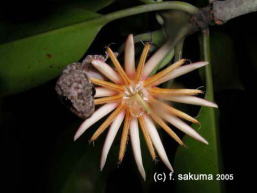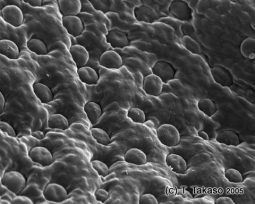学術論文に使用した画像(静止画・動画)
Pictorial materials used in academic publications and presentations
|
マングローブ植物の受粉機構に関する研究
Studies on the pollination mechanisms in mangrove plants
|
種子植物(裸子植物と被子植物)が種子を作るときに受粉が必要ですが、この際に花粉が運ばれます。西表島のマングローブ植物で受粉様式を調べていますが、この研究によって以下の成果が得られています。
Pollination is an essential event in the production of seeds in seed plants
(gymnosperms and angiosperms). We study pollination mechanisms in mangrove
plants, and the following results are obtained in the course of the studies.
|
1 |
オヒルギの花からは多量の花密が分泌されること、花には、蛾、アリ等の様々な小動物が訪れること、また、この蛾とアリを食べるためにヤモリが訪れることがわかりました。
Copious nectar is secreted from Bruguiera flowers, and various small animals such as moths and ants visit the flowers. Geckos also visit the flowers to eat the moths and ants.
|

画像をクリックしてください。
Please click this picture. |
2 |
ヤエヤマヒルギでは、これまで花粉が主に風によって運ばれると考えられていましたが、多種の蛾が受粉に関わっていることがわかりました。
Wind is known as main vector in the pollination of Rhizophora. We revealed that many moths are also involved in its pollination.
|

画像をクリックしてください。
Please click this picture. |
3 |
ヒルギダマシで花の蜜腺を走査電子顕微鏡で撮影することができました。
Nectar of Avicennia is examined and photographed with a scanning electron microscope.
|

画像をクリックしてください。
Please click this picture. |
|
|
これらの成果は下記の論文で発表します。
These results will be published in the following papers.
Takaso T., Kimoto Y., Kawakubo N., Yasuda K. and Sakuma F. Pollination mechanism in relation to floral development in Bruguiera. Journal of Plant Research. Submitted.
Takaso T., Kimoto Y., Kawakubo N., Yasuda K. and Sakuma F. Pollination
mechanism in Avicennia and Rhizophora with reference to nectar secretion. Journal of Plant Research. Submitted.
|
|
|